It looks like you're using an Ad Blocker.
Please white-list or disable AboveTopSecret.com in your ad-blocking tool.
Thank you.
Some features of ATS will be disabled while you continue to use an ad-blocker.
share:
reply to post by r4winds
I agree with you about keeping the PNW quiet. Love your Chief Seattle quote, r4winds.
USGS has a "Practical Guide to the Pacific Northwest Earthquakes" linked here. It's a go-at-your-own-pace (they estimate 90 minutes) interactive course with descriptions of different types of earthquakes, precationary steps to take, etc, with short quizzes after each section.
There are some good graphics and information for people who aren't sure of what can happen and how they should prepare.
I agree with you about keeping the PNW quiet. Love your Chief Seattle quote, r4winds.
USGS has a "Practical Guide to the Pacific Northwest Earthquakes" linked here. It's a go-at-your-own-pace (they estimate 90 minutes) interactive course with descriptions of different types of earthquakes, precationary steps to take, etc, with short quizzes after each section.
There are some good graphics and information for people who aren't sure of what can happen and how they should prepare.
reply to post by Olivine
[color=sky blue] Thank you, Olivine. I like your Buddhist quote. [color=sky blue] I successfully completed the first section of the Cascadia program you linked to. I even passed the quiz. It was very eye opening. Hopefully, I can finish by the end of the week. I hope to move from ats earthquake noob to ats earthquake newbie.
[color=sky blue] Thank you, Olivine. I like your Buddhist quote. [color=sky blue] I successfully completed the first section of the Cascadia program you linked to. I even passed the quiz. It was very eye opening. Hopefully, I can finish by the end of the week. I hope to move from ats earthquake noob to ats earthquake newbie.
reply to post by Olivine
[color=sky blue]I checked PNSN and it looks pretty quiet, a minimum amount of dots are being generated and those are trending toward the 40 km plate depth. Strange thing is, there are holes in the information generated as PNSN doesn't let a couple days in May be plotted. Wonder if they're affected by the sequestration cuts.
[color=sky blue]I checked PNSN and it looks pretty quiet, a minimum amount of dots are being generated and those are trending toward the 40 km plate depth. Strange thing is, there are holes in the information generated as PNSN doesn't let a couple days in May be plotted. Wonder if they're affected by the sequestration cuts.
edit on 11-5-2013 by r4winds because: my code is showing...again
It's been quiet around Cascadia for a while, but a few recent events are post worthy.
A small outburst of quake activity well offshore of northern California on the 20th.
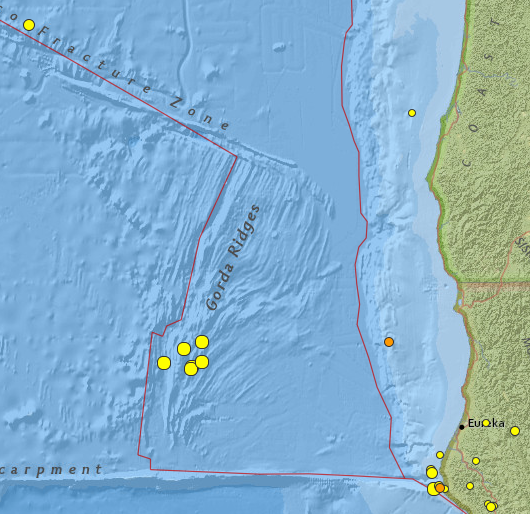 source
source
(zoomed to area, past 7 days, all mags)
All 6 quakes happened within 1 hour and were Mag 4.1 to 4.4 mb.
Plus this Mag 3.9 out on the Blanco Fracture Zone on the 21st.
Last night was this innocuous little wiggle 68 km off the coast.
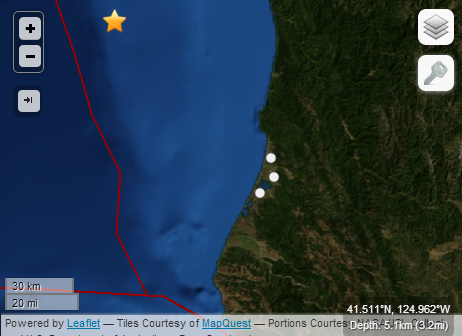
Mag 2.3 offshore Crescent City, CA & PNSN data
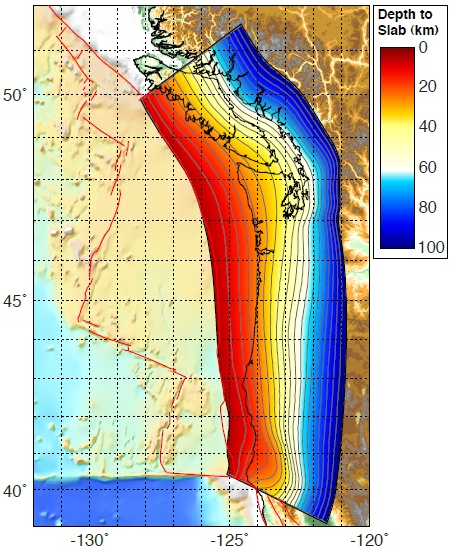 source
source
Looking at the slab contour map, it's possible this small quake was on the very toe of the subduction interface. It's hard to be certain; without OBS (ocean bottom seismometer) data to the west of the epicenter, it is difficult to constrain the location accurately.
Finally, the tremor has been persistent in central California for the past 2 weeks, and the zone under Vancouver Island had a vigorous pop of activity on the 18th, 19th, 20th & 21st.
 source
source
Just to stay within this thread's theme, a link to a 2012 article by Segall and Bradley (1.13Mb .pdf) concerning slow-slip and megathrust earthquakes nucleation.
Using the authors' model, they conclude that slow-slip events (ETS) evolve into dynamic ruptures, rather than triggering them by transferring stress. Their model predicts 2 mechanisms for dynamic rupture:
1.The big megathrust initiates at the updip margin of the slow-slip event, or
2. The big megathrust (fast slip) initiates inside the slow-slip event.
From the article conclusion:
So if their model is accurate, yes the odds of a big thrust quake increase during a slow-slip episode, and no, there is no warning sign.
A small outburst of quake activity well offshore of northern California on the 20th.

(zoomed to area, past 7 days, all mags)
All 6 quakes happened within 1 hour and were Mag 4.1 to 4.4 mb.
Plus this Mag 3.9 out on the Blanco Fracture Zone on the 21st.
Last night was this innocuous little wiggle 68 km off the coast.

Mag 2.3 offshore Crescent City, CA & PNSN data

Looking at the slab contour map, it's possible this small quake was on the very toe of the subduction interface. It's hard to be certain; without OBS (ocean bottom seismometer) data to the west of the epicenter, it is difficult to constrain the location accurately.
Finally, the tremor has been persistent in central California for the past 2 weeks, and the zone under Vancouver Island had a vigorous pop of activity on the 18th, 19th, 20th & 21st.
 source
source Just to stay within this thread's theme, a link to a 2012 article by Segall and Bradley (1.13Mb .pdf) concerning slow-slip and megathrust earthquakes nucleation.
Using the authors' model, they conclude that slow-slip events (ETS) evolve into dynamic ruptures, rather than triggering them by transferring stress. Their model predicts 2 mechanisms for dynamic rupture:
1.The big megathrust initiates at the updip margin of the slow-slip event, or
2. The big megathrust (fast slip) initiates inside the slow-slip event.
From the article conclusion:
If either process occurs in nature the probability of a dynamic rupture does increase during ETS events. In neither case, however, is there obvious indication that dynamic instability is imminent prior to the event.
So if their model is accurate, yes the odds of a big thrust quake increase during a slow-slip episode, and no, there is no warning sign.
reply to post by Olivine
[color=cyan] Thank you for the update, Olivine. I checked PNSN and plotted the jiggles for the past week and there are no jiggles north of the California/Oregon border.
Being a noob I wanted to ask, does this happens frequently?
I only ask because ever since I started following this thread and plotting the jiggles on PNSN, I have never seen a completely blank slate in Oregon or Washington.
[color=cyan] Thank you for the update, Olivine. I checked PNSN and plotted the jiggles for the past week and there are no jiggles north of the California/Oregon border.
Being a noob I wanted to ask, does this happens frequently?
I only ask because ever since I started following this thread and plotting the jiggles on PNSN, I have never seen a completely blank slate in Oregon or Washington.
reply to post by r4winds
I would say that it happens with some regularity; maybe every 8-12 weeks, lasting for a few days.
The past 12 hours show low levels of tremor spreading up the entire zone. (once the link loads, hit the "12" button)
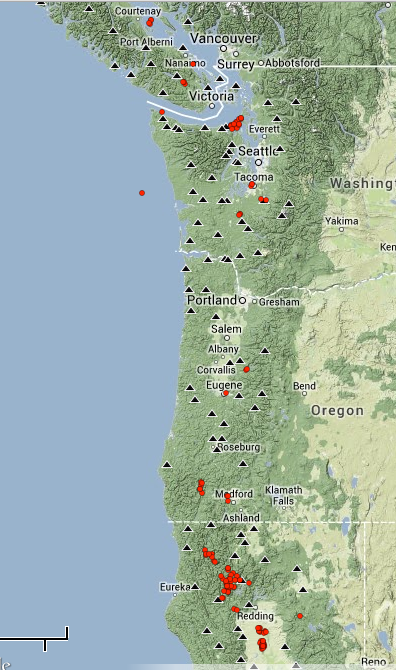
Offshore northern California had a couple of small shakes in the past 2 hours. plate boundary borehole 046
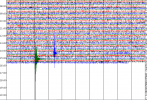
I would say that it happens with some regularity; maybe every 8-12 weeks, lasting for a few days.
The past 12 hours show low levels of tremor spreading up the entire zone. (once the link loads, hit the "12" button)

Offshore northern California had a couple of small shakes in the past 2 hours. plate boundary borehole 046

edit on 6/8/2013 by Olivine because: add a pic and link
Here is a look at the past 24 hours of tremor--a definite change in pattern from the previous few days.
It always puts me a bit "on edge" when I see these deep burbles spanning the length of the CSZ.
I'll be holding my breath until something changes.

It always puts me a bit "on edge" when I see these deep burbles spanning the length of the CSZ.
I'll be holding my breath until something changes.

Yesterday, June 9th, experienced tremor in a very similar pattern to the day before.
Does it seem like these small outbursts of tremor that jump up and down the length of Cascadia are happening more frequently? It's raining today; I'll try to figure out if they are, or if I'm just imagining it.
Image from PNSN tremor page
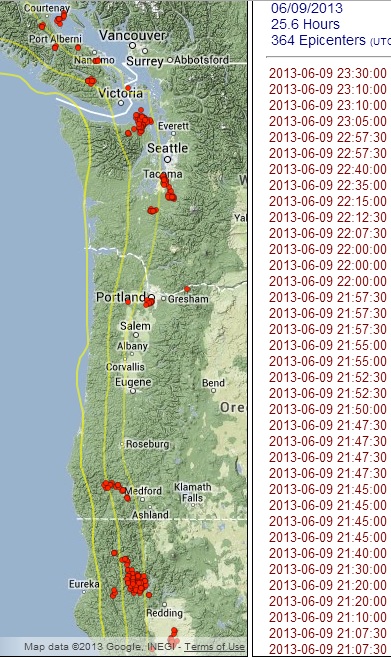
Does it seem like these small outbursts of tremor that jump up and down the length of Cascadia are happening more frequently? It's raining today; I'll try to figure out if they are, or if I'm just imagining it.
Image from PNSN tremor page

While perusing the activity (or lack there of) in the Pacific Northwest, some GPS data caught my attention.
This is GPS station TRND located in Trinidad, California.
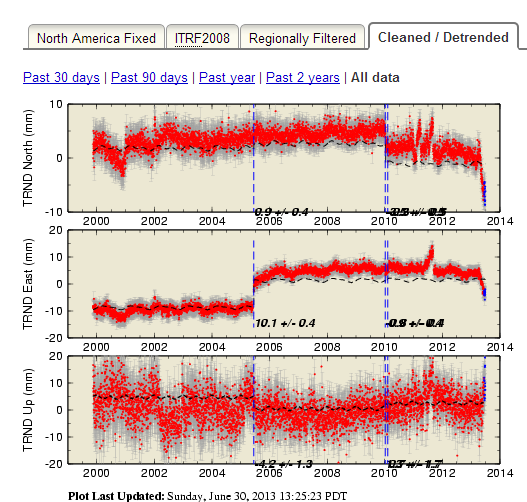
The link shows the trend against a fixed North America, while this image is the same data cleaned & detrended.
The single-dash blue lines mark the 15 June 2005 Mag 7.2 left-lateral strike-slip earthquake located in the middle of the Gorda plate.
The double-dash blue lines mark the 10 January 2010 Mag 6.5 left-lateral strike-slip earthquake located 35 km WNW of Fernadale, CA.
The current movement over the past 60 days, especially in the E-W direction, looks to be similar in size (10 mm) to the amount of movement generated by the Mag 7.2. But there hasn't been an earthquake, or a sustained slow-slip/tremor episode in the area.
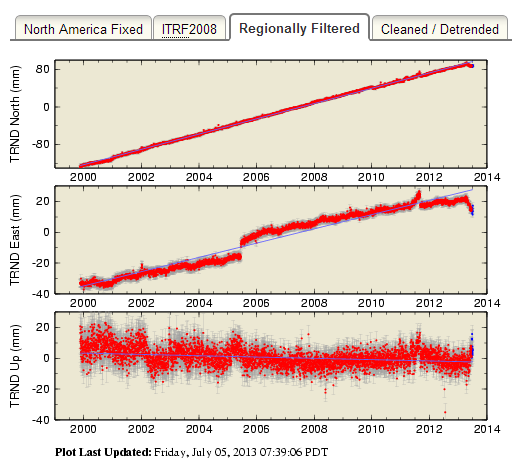 (same data, but regionally filtered.)
(same data, but regionally filtered.)
During the year prior to the 2005 EQ, the movement in the E-W direction dipped below it's long-term trend line, as seen in the image above.
Are we looking at the lead-up to a similar sized event? Something bigger? Nothing but a short-term anomaly?
In April 1992 there was a Mag 7.1 thrust type earthquake under Petrolia, CA, followed the next day by two Mag 6+ strike-slips, farther west on the Mendocino fault. Unfortunately, I haven't been able to find GPS data for that time frame to compare to.
This link shows the GPS stations in the CA Coast Range (north) area. If you click the Longitude image, you can see that a major of the stations in the area have taken a western tact; some, such as TRND, more strongly than others. The N-S directions are a bit muddled. Some are showing southerly movement, while others in the area continue their push north, which is normal for the area.
Here is a map of GPS velocities, to see the longterm movement.
On a side note, it seems to me that another ETS episode is about due* in the northern California area.
(*if they continue to exhibit the cyclic nature observed in the past few years.)[
editby]edit on 7/5/2013 by Olivine because: add info
This is GPS station TRND located in Trinidad, California.

The link shows the trend against a fixed North America, while this image is the same data cleaned & detrended.
The single-dash blue lines mark the 15 June 2005 Mag 7.2 left-lateral strike-slip earthquake located in the middle of the Gorda plate.
The double-dash blue lines mark the 10 January 2010 Mag 6.5 left-lateral strike-slip earthquake located 35 km WNW of Fernadale, CA.
The current movement over the past 60 days, especially in the E-W direction, looks to be similar in size (10 mm) to the amount of movement generated by the Mag 7.2. But there hasn't been an earthquake, or a sustained slow-slip/tremor episode in the area.

During the year prior to the 2005 EQ, the movement in the E-W direction dipped below it's long-term trend line, as seen in the image above.
Are we looking at the lead-up to a similar sized event? Something bigger? Nothing but a short-term anomaly?
In April 1992 there was a Mag 7.1 thrust type earthquake under Petrolia, CA, followed the next day by two Mag 6+ strike-slips, farther west on the Mendocino fault. Unfortunately, I haven't been able to find GPS data for that time frame to compare to.
This link shows the GPS stations in the CA Coast Range (north) area. If you click the Longitude image, you can see that a major of the stations in the area have taken a western tact; some, such as TRND, more strongly than others. The N-S directions are a bit muddled. Some are showing southerly movement, while others in the area continue their push north, which is normal for the area.
Here is a map of GPS velocities, to see the longterm movement.
On a side note, it seems to me that another ETS episode is about due* in the northern California area.
(*if they continue to exhibit the cyclic nature observed in the past few years.)[
editby]edit on 7/5/2013 by Olivine because: add info
edit on 7/5/2013 by Olivine because: (no reason given)
edit on
7/5/2013 by Olivine because: it takes me a few times to get it
reply to post by Olivine
I love the detail and explanation in your posts!!!!
I know I am not supposed to give a pat on the back as my only contribution to this thread......However....
Just sayin'...........keep it up!
Very interesting stuff!
Maybe this would back up Marialady's prediction of a 'big one' in So. Cal. in the near future.
I love the detail and explanation in your posts!!!!
I know I am not supposed to give a pat on the back as my only contribution to this thread......However....
Just sayin'...........keep it up!
Very interesting stuff!
Maybe this would back up Marialady's prediction of a 'big one' in So. Cal. in the near future.
edit on 5-7-2013 by radpetey because: (no
reason given)
edit on 5-7-2013 by radpetey because: (no reason given)
Hey, it's been fairly quiet on the US west coast.
A mag 4.2 popped off the Oregon coast, July 16th saw some tremor under Vancouver Island in BC, and today, tremor return with some vigor to northern California.
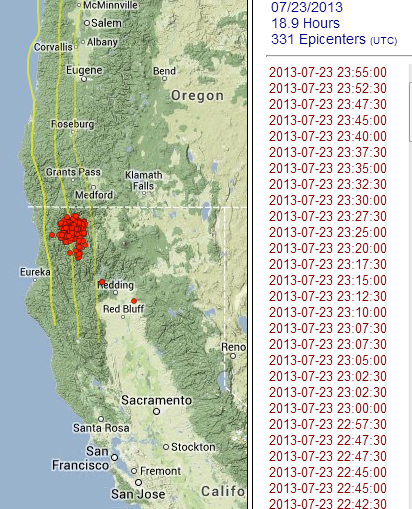
source
Just wanted to post a small update. Has anyone read any new research on the area? I think I'll look around for some new material this weekend.
Cheers,
Olivine
A mag 4.2 popped off the Oregon coast, July 16th saw some tremor under Vancouver Island in BC, and today, tremor return with some vigor to northern California.

source
Just wanted to post a small update. Has anyone read any new research on the area? I think I'll look around for some new material this weekend.
Cheers,
Olivine
reply to post by Olivine
Hey Olivine! Sorry I haven't checked in here in so long. Thank you for all the great updates and info!
I guess it's a good thing I haven't had much to say. Makes me a bit nervous though when it stays so quiet for so long!!
Hey Olivine! Sorry I haven't checked in here in so long. Thank you for all the great updates and info!
I guess it's a good thing I haven't had much to say. Makes me a bit nervous though when it stays so quiet for so long!!
Agreed, Thanks to you and a star and flag for all the PNW information. We are not in a good place if it ever goes bad so I tend to follow all the West
coast quake info and very much appreciate the updates also.
We had a good size one a few yrs back, not sure when it was, but it was epicentered about 3 miles from here and I think that was one of the most frightening things I ever been through. It flexed my house so bad a lot of the trim popped off my walls and had to be re-nailed. Left me with a lot more respect for them after that.
We had a good size one a few yrs back, not sure when it was, but it was epicentered about 3 miles from here and I think that was one of the most frightening things I ever been through. It flexed my house so bad a lot of the trim popped off my walls and had to be re-nailed. Left me with a lot more respect for them after that.
reply to post by westcoast
It's my pleasure. Yes, I get a bit nervous, too, when it's quiet.
This image shows the tremor over the past week; 21 - 28 July. There was a handful of tremor located under northern Washington and Vancouver Island, but I cropped the image to be able to zoom into northern CA/southern OR.
To me, it looks like the deep tremor is trying to migrate north. Time will tell.
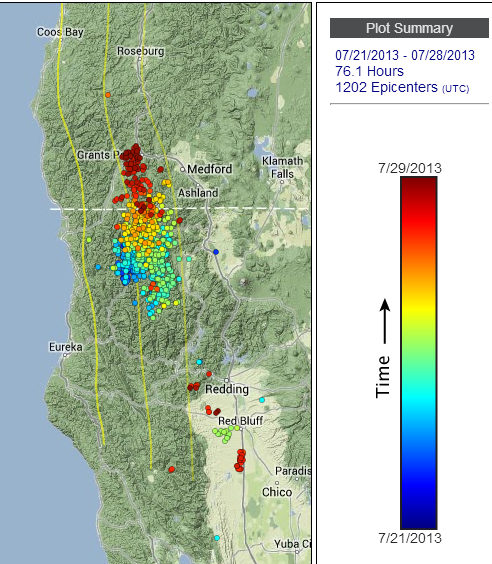
source--PNSN
Looking at the past 6 and 12 hours on the Real-time tremor map, there is still activity, but it looks to be back-tracking at the moment; which appears "normal", in that we have seen that behavior previously during the large ETS events in northern WA/southern Canada.
I find it curious that once this tremor bit got started down in the southern end of the CSZ, moderate quakes begin popping off near the northern end: Mag 5.0, 26 July 2013. The "seesaw" mechanism at work again, Westcoast.
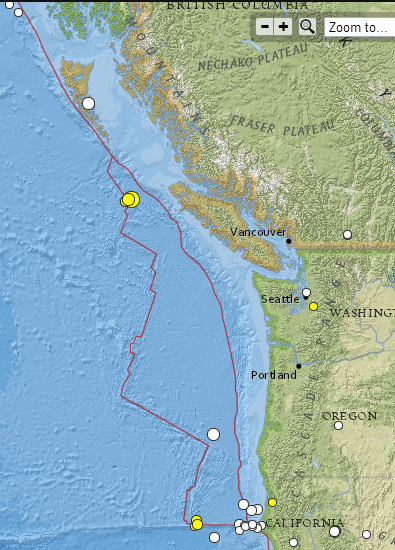
source--USGS
There has been a steady release of small EQ's near the Mendocino Triple Junction, and further west toward the spreading center. Another, this morning, that hasn't been listed yet. It's probably only a mag 3.0 or smaller, and offshore 150 kms or so:
Still watching...
ETA: ...and another little pop Mag 2.7, just south of Ferndale, CA
It's my pleasure. Yes, I get a bit nervous, too, when it's quiet.
This image shows the tremor over the past week; 21 - 28 July. There was a handful of tremor located under northern Washington and Vancouver Island, but I cropped the image to be able to zoom into northern CA/southern OR.
To me, it looks like the deep tremor is trying to migrate north. Time will tell.

source--PNSN
Looking at the past 6 and 12 hours on the Real-time tremor map, there is still activity, but it looks to be back-tracking at the moment; which appears "normal", in that we have seen that behavior previously during the large ETS events in northern WA/southern Canada.
I find it curious that once this tremor bit got started down in the southern end of the CSZ, moderate quakes begin popping off near the northern end: Mag 5.0, 26 July 2013. The "seesaw" mechanism at work again, Westcoast.

source--USGS
There has been a steady release of small EQ's near the Mendocino Triple Junction, and further west toward the spreading center. Another, this morning, that hasn't been listed yet. It's probably only a mag 3.0 or smaller, and offshore 150 kms or so:
Still watching...
ETA: ...and another little pop Mag 2.7, just south of Ferndale, CA
edit on 7/29/2013 by Olivine because: (no reason given)
reply to post by Olivine
[color=cyan] Thank you West Coast for starting this thread. We definitely need to stay informed about Cascadia's movements.
Thank you Olivine for staying on top of the PNSN tremor site and keeping us up to date on the ETS.
I appreciate you both!
I saw that concentration of dots in between Redding and Portland. Hopefully the normal ETS firing off.
[color=cyan] Thank you West Coast for starting this thread. We definitely need to stay informed about Cascadia's movements.
Thank you Olivine for staying on top of the PNSN tremor site and keeping us up to date on the ETS.
I appreciate you both!
I saw that concentration of dots in between Redding and Portland. Hopefully the normal ETS firing off.
edit on 30-7-2013 by r4winds
because: Darn code is showing...again.
Originally posted by Olivine
Another, this morning, that hasn't been listed yet. It's probably only a mag 3.0 or smaller, and offshore 150 kms or so:
ETA: ...and another little pop Mag 2.7, just south of Ferndale, CA
The 'blue' earthquake at 09:07UTC on the image above was eventually listed as a mag 2.8, 78 km off the coast of Ferndale, CA. (my estimate was a tad high and too far offshore)
The 'Mag 2.7' linked above was modified to a mag 2.8.
The 2 days since my last tremor update show 3 discrete centers of activity. Strange. Most of the time, the tremor migrates uniformly from one area to the next.
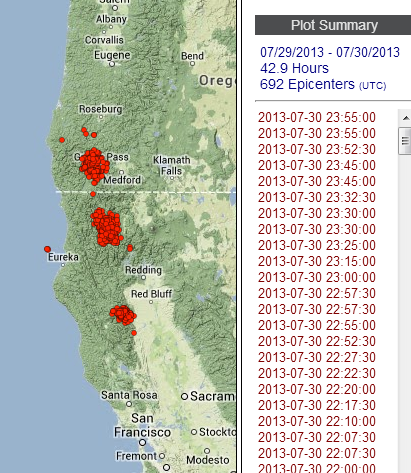
source PNSN
Since the update last night, the tremor activity continues, but looks to be slowing a bit. Real-time tremor
_________________________
Side-track:
This mag 2.2 last Tuesday (23 July), northwest of Bend, OR was interesting--a deep, long-period earthquake. Normally they are found near volcanoes, but this one wasn't directly associated with one.
reply to post by Olivine
From what I've been seeing with the earthquakes near the triple junction is there should be a 3.5 to a 4.5 off the coast of Oregon around 5-10 days. Most likely due west of Eugene. It's a little pattern I've noticed whenever there's some activity near the triple junction. It's a stress reliever..
From what I've been seeing with the earthquakes near the triple junction is there should be a 3.5 to a 4.5 off the coast of Oregon around 5-10 days. Most likely due west of Eugene. It's a little pattern I've noticed whenever there's some activity near the triple junction. It's a stress reliever..
reply to post by Isaac (RIP DUSTIN)
Gee, you nailed the Mag 4.5 bit!
You are also correct about relieving stress--in this case, stress inside the Gorda plate, with left-lateral movement on a NE striking fault.
_________________________
Strange few hours of activity in the PNW, eh?
Early yesterday saw Mt. Lassen experience a small swarm of earthquakes centered 4 kms under the volcano.
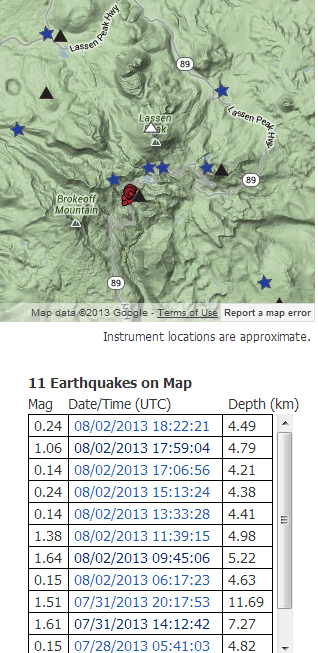 (image found at above link)
(image found at above link)
Then we move up north to Washington.
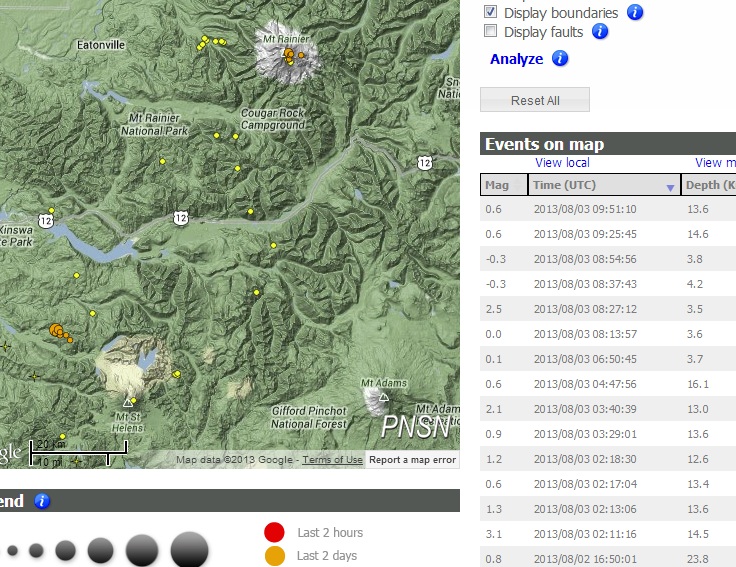
Mount St. Helens goes off at 02:11:16 UTC with a Mag 3.1, 14 kms below the NW flank of the volcano. This was followed by at least 5 more earthquakes over the next few hours, becoming slightly more shallow with each one. (scroll to the bottom of the monitoring page to see the depths graphically)
Then Mt. Rainier follows up with a smaller swarm, about 3.8 km deep, directly under the volcano.
This is a cross-section of the recent EQ's under Rainier, from N to S. you can see the area included below the image.

(image created using the "analyze" feature on the PNSN recent earthquakes page)
Just to be thorough, this is the past 3 days of tremor since I last posted an update.
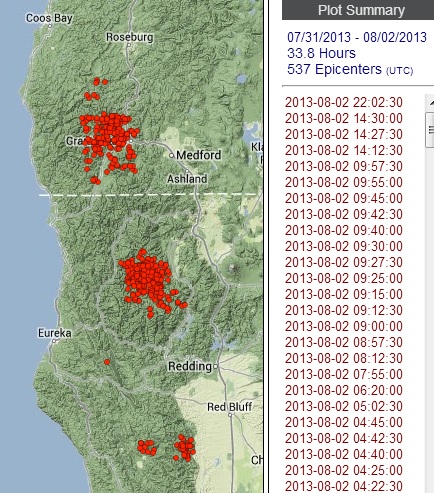
source
I was looking to see if the tremor correlated in any way with the earthquakes, but all I see looking at the past 24 hours on the realtime tremor map, is the activity jumping back and forth, from north to south. (set map to "24", and move your cursor over the times on the right to see the locations--I wish I knew how to animate this)
I'm off to check out the GPS in the region...happy weekend, All.
ETA: This isn't in the PNW, but odd timing that Yellowstone has it's largest EQ in the past 3+ weeks shortly after the quakes in norCal and at MSH. What is going on with the volcanoes?
Mt. Saint Helens just had another mag 2.1. Looking at the focal mechansims of this one & the mag 3.1 (linked above), these are probably NW striking, right-lateral tectonic faults--but that's just my amatuer analysis.
Gee, you nailed the Mag 4.5 bit!
You are also correct about relieving stress--in this case, stress inside the Gorda plate, with left-lateral movement on a NE striking fault.
_________________________
Strange few hours of activity in the PNW, eh?
Early yesterday saw Mt. Lassen experience a small swarm of earthquakes centered 4 kms under the volcano.

Then we move up north to Washington.

Mount St. Helens goes off at 02:11:16 UTC with a Mag 3.1, 14 kms below the NW flank of the volcano. This was followed by at least 5 more earthquakes over the next few hours, becoming slightly more shallow with each one. (scroll to the bottom of the monitoring page to see the depths graphically)
Then Mt. Rainier follows up with a smaller swarm, about 3.8 km deep, directly under the volcano.
This is a cross-section of the recent EQ's under Rainier, from N to S. you can see the area included below the image.

(image created using the "analyze" feature on the PNSN recent earthquakes page)
Just to be thorough, this is the past 3 days of tremor since I last posted an update.

source
I was looking to see if the tremor correlated in any way with the earthquakes, but all I see looking at the past 24 hours on the realtime tremor map, is the activity jumping back and forth, from north to south. (set map to "24", and move your cursor over the times on the right to see the locations--I wish I knew how to animate this)
I'm off to check out the GPS in the region...happy weekend, All.
ETA: This isn't in the PNW, but odd timing that Yellowstone has it's largest EQ in the past 3+ weeks shortly after the quakes in norCal and at MSH. What is going on with the volcanoes?
Mt. Saint Helens just had another mag 2.1. Looking at the focal mechansims of this one & the mag 3.1 (linked above), these are probably NW striking, right-lateral tectonic faults--but that's just my amatuer analysis.
edit on 8/3/2013
by Olivine because: add info
The northern end of the CSZ had a Mag 5.3 mwb almost 3 hours ago.
(updated @ 16:40 UTC)
I guess because it is Sunday, they are a bit slow getting the focal mechanism worked out. Even the PNSN is waiting for the info (from their FB page), to determine if this EQ was on the subduction interface or not. They have it listed as a Mag 5.5 Ml.
It could be a strike-slip on the nootka fault.
EMSC has it as Mag 5.4 Mw
Updated: It looks like USGS has decided it was a strike-slip.
This is a link to the nearest borehole seismometer in the plate boundary observatory; PB928 about 190 km away:
I guess because it is Sunday, they are a bit slow getting the focal mechanism worked out. Even the PNSN is waiting for the info (from their FB page), to determine if this EQ was on the subduction interface or not. They have it listed as a Mag 5.5 Ml.
It could be a strike-slip on the nootka fault.
EMSC has it as Mag 5.4 Mw
Updated: It looks like USGS has decided it was a strike-slip.
This is a link to the nearest borehole seismometer in the plate boundary observatory; PB928 about 190 km away:
edit on 8/4/2013 by Olivine because: (no
reason given)
edit on 8/4/2013 by Olivine because: for accuracy
edit on 8/4/2013 by Olivine because: (no reason
given)
The latest Cascades Volcano Observatory update confirms that the ongoing swarm of
activity NW of Mt. Saint Helens is tectonic in origin.
Interesting that they don't give a characterization of the quakes under Rainier, except to say that they happen a few times a year.
Interesting that they don't give a characterization of the quakes under Rainier, except to say that they happen a few times a year.
A small swarm of 17 located earthquakes occurred at Mount Rainier between 08/02-08/09, all located under the summit at 3-4 km depth. The largest was a M 2.3 on 08/03, the rest were very small. Such swarms occur a few times per year at Rainier. The other seismicity of note this week is an ongoing swarm of earthquakes ~13 miles northwest of Mount St. Helens (MSH). The first earthquakes in this swarm occurred 08/02, and as of today 41 events have occurred with the largest a M 3.1 on 08/02. These are interpreted to be tectonic earthquakes that are not directly related to MSH. Such earthquakes are very common in the area around MSH
